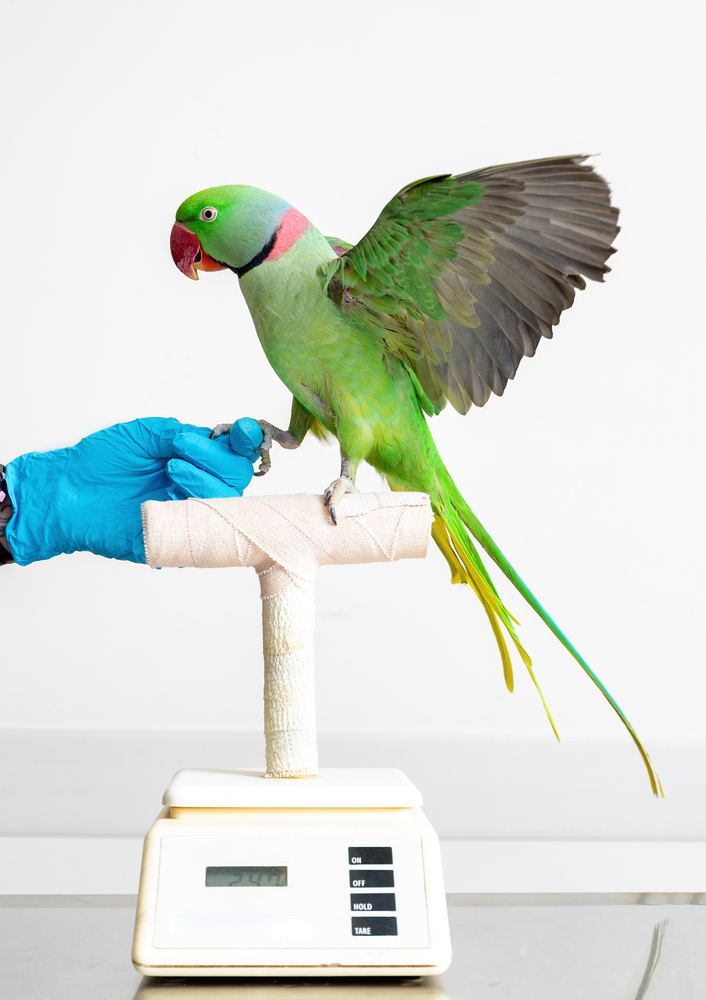What simple behavior could save your parrot’s life? Scale training! Sounds silly but getting and recording regular weights on your parrot can be a life saver. One of the things we know about parrots is that they have a tendency to mask signs of illness. The theory behind this is that in the wild, a parrot who appears sick might be a prime target for a predator. Therefore, it is to a parrot’s advantage to “pretend” to be healthy, even if they are not.
Many times, when a parrot is ill, they consume less of their food and water. Sometimes they don’t process food properly. Such parrots can drop weight very quickly. Because parrots can easily fluff up their feathers and look quite robust, weight loss may not be visible to the naked eye. But the scale doesn’t lie. A sick bird can drop quite a few grams, even overnight. And this rapid weight loss can be a signal to parrot owners to take their bird to their avian veterinarian.
A scale that can be used to weigh a parrot can be purchased at most office supplies stores. Look in the postage scale section. Another place you can find a gram scale is in a kitchen supply store. Some people use scales to weigh food when cooking. Be sure to pick one that weighs in one-gram increments. Five- or ten-gram increments are too great of a fluctuation for weighing parrots.
Some people prefer to use a scale with a perch attached to it. Avian specialty stores often carry these. However, I found it quite simple to train a parrot to step from my hand onto the flat surface of a scale. Just be sure to place the scale near the edge of the counter so the bird’s tail can hang freely. If the tail is resting on a surface it will influence the number on the scale and the weight won’t be accurate.
I weigh my own parrots about once a week just to make sure they are maintaining a healthy weight. Keep in mind each bird is an individual and the perfect weight for your bird may not be ideal for someone else’s parrot. For example, the two Amazon parrots in my home differ by 100 grams. What I look for is changes within each individual animal’s records as opposed to comparing the two birds to each other.
It takes practice and exposure to a number of parrots, but another great way to evaluate your parrot’s condition is to feel the muscle on either side of their keeled sternum. This is called body condition scoring. There are several body-scoring charts available for birds to help you interpret what you are feeling for when checking a parrot’s condition by touch. This takes some practice, and it helps to have an experienced person by your side to help you learn how to do this properly. But if body condition scoring doesn’t sound like your cup of tea, rest assured that scale training is super easy and something most parrots can learn to eagerly do in one to two training sessions. Bonus: Scale training at home helps to ensure that your parrot’s veterinary visits are Fear Free because they’re already used to being weighed. I hope you will give this behavior a try with the parrots in your life. It’s a life saver!
This article was reviewed/edited by board-certified veterinary behaviorist Dr. Kenneth Martin and/or veterinary technician specialist in behavior Debbie Martin, LVT.
Barbara Heidenreich is an animal training consultant specializing in exotic animals. She consults worldwide working with zoos, universities, veterinary professionals, and conservation projects. She has worked onsite with over 80 facilities in 27 countries. She is an adjunct instructor at Texas A & M University. She has authored two books and contributed to four veterinary textbooks. She is a co-author of two Fear Free® Avian Certification Courses. Much of her work focuses on training exotic species to cooperate in medical care. Barbara is an advisor for the Animal Training Working Group and the Parrot Taxon Advisory Group for the European Association of Zoos and Aquariums. She has provided her expertise to conservation projects The Kakapo Recovery Program and The Borneo Orangutan Survival Foundation. Her goal is to leave behind a legacy of kindness to animals by sharing her expertise.
Want to stay in the loop on the latest and greatest in keeping your pet happy and healthy? Sign up for our free newsletter by clicking here!








